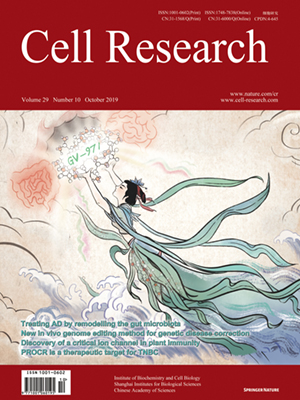
Advanced Search
Submit Manuscript
Advanced Search
Submit Manuscript
Volume 29, No 10, Oct 2019
ISSN: 1001-0602
EISSN: 1748-7838 2018
impact factor 17.848*
(Clarivate Analytics, 2019)
Volume 29 Issue 10, October 2019: 846-861 |
Nicolas Jacquelot 1,2,3,4,26 , Takahiro Yamazaki 1,3, Maria P. Roberti 1,3,5, Connie P. M. Duong 1,3, Miles C. Andrews 6,7,8,Loic Verlingue 3,9, Gladys Ferrere 1,3,5, Sonia Becharef 1,3, Marie Vétizou 1,3, Romain Daillère 1,3, Meriem Messaoudene 1,3, David P. Enot 3,10, Gautier Stoll 10,11,12,13,14, Stefano Ugel 15, Ilaria Marigo16, Shin Foong Ngiow 17,18, Aurélien Marabelle 1,2,3, Armelle Prevost-Blondel 14,19,20, Pierre-Olivier Gaudreau 6, Vancheswaran Gopalakrishnan6, Alexander M. Eggermont3, Paule Opolon3,Christophe Klein11, Gabriele Madonna21, Paolo A. Ascierto 21, Antje Sucker22, Dirk Schadendorf 22, Mark J. Smyth 17,18,Jean-Charles Soria 2,3,4,9, Guido Kroemer 2,3,4,10,11,12,13,14,23,24, Vincenzo Bronte15, Jennifer Wargo 6,25 and Laurence Zitvogel 1,2,3,4,5
1INSERM U1015, Gustave Roussy, 114 rue Edouard Vaillant, 94805 Villejuif Cedex, France; 2Université Paris-Saclay, Le Kremlin-Bicêtre, France; 3Institut de Cancérologie Gustave Roussy Cancer Campus (GRCC), 114 rue Edouard Vaillant, Villejuif, France; 4Faculté de Médecine–Université Paris-Sud, Le Kremlin-Bicêtre, France; 5CIC Biotherapie IGR Curie, CIC1428, Gustave Roussy Cancer Campus, Villejuif, France; 6Department of Surgical Oncology, MD Anderson Cancer Center, Houston, TX, USA; 7Olivia Newton-John Cancer Research Institute, Heidelberg, VIC, Australia; 8School of Cancer Medicine, La Trobe University, Heidelberg, VIC, Australia; 9Drug Development Department (DITEP), Gustave Roussy, Université Paris-Sud, Université Paris-Saclay, Villejuif, France; 10Metabolomics and Cell Biology Platforms, Gustave Roussy Cancer Campus, Villejuif, France; 11INSERM U1138, Centre de Recherche des Cordeliers, Paris, France; 12Equipe 11 labellisée par la Ligue contre le Cancer, Centre de Recherche des Cordeliers, Paris, France; 13Université Pierre et Marie Curie, Paris, France; 14Université Paris Descartes, Sorbonne Paris Cité, Paris, France; 15Department of Medicine, Verona University Hospital, Verona, Italy; 16Istituto Oncologico Veneto IOV-IRCCS, Padova, Italy; 17Immunology in Cancer and Infection Laboratory, QIMR Berghofer Medical Research Institute, Herston, QLD, Australia; 18School of Medicine, University of Queensland, Herston, QLD, Australia; 19 INSERM, U1016, Institut Cochin, Paris, France; 20CNRS, UMR8104 Paris, France; 21Melanoma Cancer Immunotherapy and Innovative Therapy Unit, Istituto Nazionale Tumori IRCCS Fondazione “G. Pascale”, Napoli, Italy; 22Department of Dermatology, University Hospital, University Duisburg-Essen, Essen, Germany & German Cancer Consortium (DKTZ), Heidelberg, Germany; 23Pôle de Biologie, Hôpital Européen Georges Pompidou, AP-HP, Paris, France; 24 Department of Women’s and Children’s Health, Karolinska Institute, Karolinska University Hospital, Stockholm, Sweden; 25Department of Genomic Medicine, The University of Texas MD Anderson Cancer Center, Houston, TX, USA and 26Present address: Immunology Division, The Walter and Eliza Hall Institute of Medical Research, Melbourne, VIC, Australia
https://doi.org/10.1038/s41422-019-0224-x